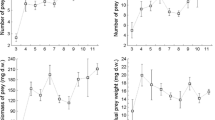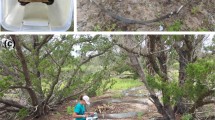Abstract
The amount of proteinaceous food that was allocated to nest construction by a native wasp (Polistes fuscatus) vs. an invasive wasp (Polistes dominulus) in North America was examined following a field experiment under natural and surplus prey foraging conditions. Wasps of the surplus prey foraging conditions were provided with prey ad libitum within an enclosed area, while wasps of the natural treatment foraged in an adjacent field-woodland site. At the end of the field experiment, each nest was tested for water absorbency, toughness, and protein concentration. The hypotheses were: (1) When all nests are equally sheltered, the invasive P. dominulus (PD) allocates less protein to nest paper construction (for waterproofing and strengthening) and more protein to developing larvae than the native P. fuscatus (PF). (2) Nests of P. dominulus are more absorbent (less waterproof) and less tough than nests of P. fuscatus. Results indicate that P. fuscatus nests from surplus prey foraging conditions were more absorbent (less waterproof) to artificial rain drops than P. dominulus nests. The toughness of nests was similar between wasp species. However, nests from the natural treatment were tougher than those from the surplus prey treatment. Nests from the natural foraging conditions had half as much protein as those from surplus prey foraging conditions. There was no correlation between nest protein concentration and the number of prey taken, the number of cells, the number of adult offspring produced, or the total wasp biomass produced per colony. For PF under surplus prey conditions, protein concentration and absorbency were negatively correlated, but for PD the correlation was positive. In conclusion, when prey were scarce, Polistes wasps allocated less protein to nest construction. Also, the introduced P. dominulus may increase production of offspring by allocating less to nest construction than that of the native P. fuscatus, and so more protein to offspring production.




Similar content being viewed by others
References
T. R. Armstrong N. E. Stamp (2003) ArticleTitleColony productivity and foundress behavior of a native versus an invasive social wasp Ecol. Entomol. 28 635–644
R. Cervo F. Zacchi S. Turillazzi (2000) ArticleTitlePolistes dominulus (Hymenoptera: Vespidae) invading North America: Some hypotheses for its rapid spread Insectes Soc. 47 155–157
K. E. Espelie D. S. Himmelsbach (1990) ArticleTitleCharacterization of pedicel, paper, and larval silk from nest of Polistes annularis (L.) J. Chem. Ecol. 16 3467–3477
G. J. Gamboa M. A. Noble M. C. Thom J. L. Togal R. I. Srinivasan B. A. Murphy (2004) ArticleTitleThe comparative biology of two sympatric paper wasps in Michigan, the native Polistes fuscatus and the invasive Polistes dominulus (Hymenoptera: Vespidae) Insectes Soc. 51 153–157
D. L. Gibo (1974) ArticleTitleA laboratory study on the selective advantage of foundress associations in Polistes fuscatus (Hymenoptera: Vespidae) Can. Entomol. 106 101–106
D. L. Gibo (1978) ArticleTitleThe selective advantage of foundress associations in Polistes fuscatus (Hymenoptera: Vespidae): A field study of the effects of predation on productivity Can. Entomol. 110 519–540
M. A. Hathaway (1981) ArticleTitlePolistes gallicus in Massachusetts (Hymenoptera: Vespidae) Psyche 88 169–173
C. G. Jones J. D. Hare S. J. Compton (1989) ArticleTitleMeasuring plant protein with the Bradford Assay. 1. Evaluation and a standard curve J. Chem. Ecol. 15 979–992
T. M. Judd J. M. Carpenter (1996) ArticleTitlePolistes dominulus (Hymenoptera: Vespidae) found in Michigan Great Lakes Entomol. 29 45–46
K. Kudo (2000) ArticleTitleVariable investments in nests and worker production by the foundresses of Polistes chinensis (Hymenoptera: Vespidae) J. Ethol. 18 37–41
K. Kudo S. Yamane H. Yamamoto (1998) ArticleTitlePhysiological ecology of nest construction and protein flow in pre-emergence colonies of Polistes chinensis (Hymenoptera Vespidae): Effects of rainfall and microclimates Ethol. Ecol. Evol. 10 171–183
K. Kudo S. Hozumi H. Yamamoto S. Yamane (2000) ArticleTitleAmino acid composition of the protein in preemergence nests of Polistes (Polistes) riparius, and its similarity to the consubgeneric wasp, P. (P.) chinensis (Hymenoptera: Vespidae) J. Ethol. 18 75–77
J. N. McGovern R. L. Jeanne M. J. Effland (1988) ArticleTitleThe nature of wasp nest paper Tappi J. 201 133–139
K. M. Pickett J. W. Wenzel (2000) ArticleTitleHigh productivity in haplometric colonies of the introduced paper wasp Polistes dominulus (Hymenoptera: Vespidae; Polistinae) J. N. Y. Entomol. Soc. 108 314–325
M. Raveret Richter (2000) ArticleTitleSocial wasp (Hymenoptera: Vespidae) foraging behavior Annu. Rev. Entomol. 45 121–150
H. K. Reeve G. J. Gamboa (1987) ArticleTitleQueen regulation of worker foraging in paper wasps: A social feedback control system (Polistes fuscatus Hymenoptera: Vespidae) Behaviour 102 147–165
D. P. A. Sands V. A. Brancatini (1991) ArticleTitleA portable penetrometer for measuring leaf toughness in insect herbivory studies Proc. Entomol. Soc. Wash. 93 786–788
T. L. Singer K. E. Espelie D. S. Himmelsbach (1992) ArticleTitleUltrastructural and chemical examination of paper and pedicel from laboratory and field nests of the social wasp Polistes metricus Say J. Chem. Ecol. 18 77–86
J. W. Wenzel J. Pickering (1991) ArticleTitleCooperative foraging, productivity, and the central limit theorem Proc. Natl. Acad. Sci. U.S.A. 88 36–38
S. Yamane Y. Itô (1994) ArticleTitleNest architecture of the Australian paper wasp Ropalidia romandi cabeti, with a note on its developmental process Psyche 101 145–158
Acknowledgments
We thank JoAnn Pfeil for aiding us in the use of the Biolinx program and the automated spectrophotometer and Karl Wilson for help in the protein analysis. This project was supported by the National Institute of Health—Bridges to the Baccalaureate Program (NIH grant 2 R25 GM56637-02, program 1006140, project 1032342) and National Science Foundation (grant DEB 9726222).
Author information
Authors and Affiliations
Corresponding author
Rights and permissions
About this article
Cite this article
Curtis, T.R., Aponte, Y. & Stamp, N.E. Nest Paper Absorbency, Toughness, and Protein Concentration of a Native vs. an Invasive Social Wasp. J Chem Ecol 31, 1089–1100 (2005). https://doi.org/10.1007/s10886-005-4249-x
Received:
Revised:
Accepted:
Published:
Issue Date:
DOI: https://doi.org/10.1007/s10886-005-4249-x




